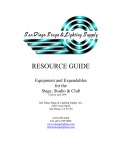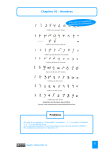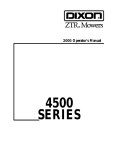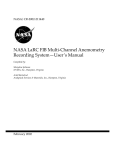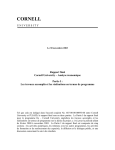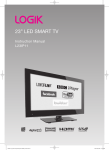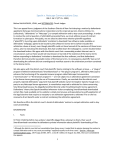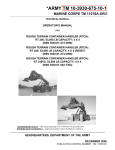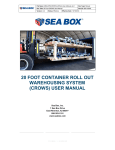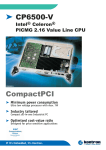Download ADA
Transcript
NOT FOR PUBLICATION IN WEST'S HAWAI'I REPORTS AND PACIFIC REPORTER NO. 29806 IN THE INTERMEDIATE COURT OF APPEALS OF THE STATE OF HAWAI'I REGINALD KEALOHA, Plaintiff-Appellant, v. KAHULUI TRUCKING & STORAGE, INC. dba A&B FLEET SERVICES; ISLAND EQUIPMENT, INC. dba AMERICAN MACHINERY; and DOE ENTITIES 1-20, Defendants-Appellees APPEAL FROM THE CIRCUIT COURT OF THE THIRD CIRCUIT (CIVIL NO. 06-1-224) MEMORANDUM OPINION (By: Nakamura, Chief Judge, and Foley and Leonard, JJ.) In this personal injury case, Plaintiff-Appellant Reginald Kealoha (Kealoha) appeals from the Judgment entered in the Circuit Court of the Third Circuit (Circuit Court)1 in favor of Defendant-Appellee Kahului Trucking & Storage Inc. dba A&B Fleet Services (A&B Fleet Services). A&B Fleet Services had been hired by Kealoha's employer, Young Brothers Ltd. (Young Brothers), to attach a top handler to a 30-ton Hi-Lift, so that it could be used to lift 40-foot shipping containers. Kealoha was injured when a shipping container being lifted broke lose and fell on his left foot and ankle. 1 The Honorable Elizabeth A. Strance presided . NOT FOR PUBLICATION IN WEST'S HAWAI'I REPORTS AND PACIFIC REPORTER The Circuit Court's Judgment was entered pursuant to orders granting two separate motions for summary judgment filed by A&B Fleet Services. The first motion for summary judgment was based on the lack of causation. The second motion was based on the alternative ground that A&B Fleet Services did not owe a duty of care to Kealoha. On appeal, Kealoha claims that the Circuit Court erred in determining on summary judgment that (1) there was no causal connection between A&B Fleet Services' alleged negligence and Kealoha's injuries; and (2) A&B Fleet Services did not owe Kealoha a duty of care. We conclude that there are genuine issues of material fact regarding whether A&B Fleet Services owed Kealoha a duty of care and whether A&B Fleet Services' alleged negligence caused Kealoha's injuries. We therefore vacate the Circuit Court's Judgment and remand the case for further proceedings. BACKGROUND I. A. Kealoha was employed by Young Brothers as a longshoremen at Young Brothers' marine terminal in Kawaihae, Hawai'i. On the day Kealoha was injured, Young Brothers requested that A&B Fleet Services connect Top Handler #102 to HiLift #215. Top Handler #102 is an attachment that permits HiLift #215, a 30-ton forklift, to lift large shipping containers from the top. Top Handler #102 was designed to permit the use of an electrical indicator light warning system when attached to compatible Hi-Lifts. The indicator light system would inform the Hi-Lift operator, through indicator lights on the Hi-Lift dashboard, whether Top Handler #102 was fully engaged with, and securely attached to, the container being lifted. Because the Top Handler #102/Hi-Lift #215 combination did not permit the use of the indicator light system, the operator of Hi-Lift #215 had to rely on mechanical "green flag" indicators located at the ends 2 NOT FOR PUBLICATION IN WEST'S HAWAI'I REPORTS AND PACIFIC REPORTER of Top Handler #102 to determine if Top Handler #102 was fully engaged. On the day in question, A&B Fleet Services attached Top Handler #102 to Hi-Lift # 215. While the Top Handler #102/Hi- Lift #215 combination was being used to move an empty 40-foot shipping container, the container broke loose and fell to the ground, crushing Kealoha's left foot and ankle. B. Young Brothers purchased the Hi-Lift #215, a Hyster brand 30-ton lift truck, in 1980. Hi-Lift #215 is a forklift which can be converted into a machine that can be used to lift and transport large shipping containers by removing the Hi-Lift's forks and connecting a top handler attachment. To transport the shipping containers, the Hi-Lift operator lowers the top handler onto the top of the container and aligns four locking mechanisms (twist locks) on the top handler with pockets located at the four corners of the container. Once the twist locks are aligned and seated in the corners of the container, the Hi-Lift operator pulls a lever which causes the twist locks to turn. Once the twist locks have rotated ninety degrees, they are fully engaged and the top handler is securely attached to the container. As a safety mechanism, the left and right ends of Top Handler #102 have mechanical "green flag" indicators, which turn synchronously with the turning of the twist locks to become displayed and visible to the Hi-Lift operator. When the green flags are fully displayed, it indicates that the twist locks have turned ninety degrees and are fully engaged. Top Handler #102 was purchased by Young Brothers in the mid-1980s, after it had purchased Hi-Lift #215. Top Handler #102 was equipped with an orange cord and plug that could be plugged into newer-model Hi-Lifts, which unlike Hi-Lift #215 had indicator lights mounted within their dashboards. When the orange cord from Top Handler #102 was connected to such Hi-Lift models, two green indicator lights on the dashboard would activate and light up when the twist locks were fully engaged. 3 NOT FOR PUBLICATION IN WEST'S HAWAI'I REPORTS AND PACIFIC REPORTER The indicator lights served as an additional safety feature beyond the mechanical green flags to indicate to the Hi-Lift operator that the twist locks were fully engaged. The indicator lights could not be used in the Top Handler #102/Hi-Lift # 215 combination. Hi-Lift #215 was not equipped with an outlet to which the orange cord on Top Handler #102 could be connected and did not have indicator lights on its dashboard. Hi-Lift #215 was sold with a prior generation top handler attachment that had indicator lights on a panel that could be attached to or separated from the Hi-Lift. Young Brothers had routinely used top handlers attached to 30-ton Hi-Lifts with no indicator lights. Young Brothers Lead Operator Quinten Chong (Chong) recalled that this combination had been used at Kawaiahae terminal (where Kealoha was employed) since at least 1990, when Chong was first stationed there. Chong did not experience problems resulting from the lack of indicator lights with this combination or the use of the mechanical green flag indicators. Originally, Young Brothers employees had attached the top handlers to the 30-ton Hi-Lifts. Sometime after 1990, Young Brothers decided to outsource the task of attaching and disconnecting the top handler to outside mechanics or contractors, such as A&B Fleet Services. In 2005, Young Brothers began using A&B Fleet Services to perform the task of attaching the top handlers to the Hi-Lifts at its Kawaihae terminal. Prior to that time, Young Brother had used another company, HT&T, to attach and detach the top handlers. Young Brothers, HT&T, and A&B Fleet Services had all connected Top Handler #102 to Hi-Lift #215, resulting in a combination with no indicator lights, during the time period each was performing this task. Attaching and removing the top handler was the most common task A&B Fleet Services performed for Young Brothers. There was no written contract between Young Brothers and A&B Fleet Services regarding these services. When Young Brothers needed to attach the top handler, it would call A&B Fleet 4 NOT FOR PUBLICATION IN WEST'S HAWAI'I REPORTS AND PACIFIC REPORTER Services and arrange to meet at the terminal. A&B Fleet Services did not have or refer to the manufacturer's service manual to determine how to connect Top Handler #102 to Hi-Lift #215. In attaching the top handler, the A&B Fleet Services mechanic would check with the Hi-Lift operator to make sure that the top handler was functioning, which would include checking the alignment of the mechanical green flags, before leaving. II. On March 26, 2006, Young Brothers requested that A&B Fleet Services connect Top Handler #102 to Hi-Lift #215. Hi-Lift #215, a 30-ton Hi-Lift, was the only Hi-Lift available for use at the time. None of Young Brothers' 30-ton Hi-Lifts were equipped with indicator lights. Young Brothers had a 35-ton Hi-Lift that was equipped with indicator lights to which Top Handler #102 could be attached, but Young Brothers did not request this combination. Because Hi-Lift #215 was not equipped with indicator lights, the orange cord and plug on Top Handler #102, which were designed to facilitate the use of an indicator lights system, was left unconnected. A&B Fleet Services mechanics Dwayne Coit (Coit) and Sidney Salboro (Salboro) attached Top Handler #102 to Hi-Lift #215 in the morning. After the top handler was attached, the person operating Hi-Lift #215, Young Brothers employee Roland Shimaoka (Shimaoka), checked to make sure the equipment was operating correctly, gave the mechanics the okay, and drove away. Shimaoka operated the Top Handler #102/Hi-Lift #215 for four hours without any problems. He was relieved in the afternoon by Young Brothers operator Patrick Tanaka (Tanaka). Around 3 p.m., Tanaka engaged an empty 40-foot shipping container with the intent to load the container on a Young Brothers barge. Tanaka transported the container approximately 75 feet to a coning station where Kealoha was responsible for placing metal cones on the bottom of the container so it could be properly stacked on the barge. During the coning process, the left side of the container released from Top Handler #102 and fell to the 5 NOT FOR PUBLICATION IN WEST'S HAWAI'I REPORTS AND PACIFIC REPORTER pier deck. The right side fell quickly thereafter crushing Kealoha's left foot and ankle. Tanaka stated that before lifting the container, he looked at the two mechanical green flag indicators on either side of Top Handler #102 and confirmed that it was fully secured. Young Brothers Safety and Environmental Manager, Nathan Kapule (Kapule), investigated the incident. According to Kapule's incident report, [t]he top [handler] was inspected and found to have a faulty twist lock/green flag indicator with the right side only. The left side twist lock/green flag indicator was inspected and no discrepancies found. This would indicate that the machine operator may have seen the faulty green flag indicator on the right side, and did not confirm the partial rotation of the left side green flag indicator and lifted the container, the left side being the true representation of the twist lock. The result was the release of the container. Kapule's report identified two causal factors for the accident: (1) a faulty right side flag indicator, and (2) machine operator error because the operator "did not confirm the twist lock/green flag indicator to the left side of the top [handler] attachment." Ultimately Kapule concluded that the root cause of the accident was operator error: Although there are several types of hi-lifts with top [handler] attachments[,] Machine Operators are trained to confirm the twist locks are secured prior to lifting a container. Therefore, in my investigation the facts indicate the left side of the top [handler] attachment of the [Hi-Lift] #215 was operating as designed. If the Machine Operator visually inspected the left side twist lock/green flag indicator prior to lifting the 40-foot Matson container he would have found the twist lock did not fully rotate. The root cause of the incident was operator error. Despite his conclusions relating to the causes of the accident, Kapule admitted during a deposition that: (1) he did not know whether the right side flag indicator was faulty at the time of the accident; and (2) Tanaka had told him that Tanaka confirmed that both green flags indicated that the locks were fully engaged. 6 NOT FOR PUBLICATION IN WEST'S HAWAI'I REPORTS AND PACIFIC REPORTER III. In his First Amended Complaint, Kealoha alleged that A&B Fleet Services: (1) negligently installed Top Handler #102 to an incompatible Hi-Lift # 215, which lacked the necessary indicator warning lights, causing a shipping container to be dropped on his foot; (2) negligently failed to follow the directives of the Hyster manufacturer's manual and international safety standards regarding indicator lights on top handlers; and (3) knowingly bypassed a critical safety system. A&B Fleet Services filed two motions for summary judgment, each asserting alternative grounds on which summary judgment could be granted. In its first motion for summary judgment, A&B Fleet Services argued that no causal connection existed between its alleged negligent conduct, i.e. attaching Top Handler #102 to a Hi-lift without indicator lights, and Kealoha's injuries. The Circuit Court granted A&B Fleet Services' First Motion for Summary Judgment, concluding that there is no genuine issue of material fact in dispute and that [A&B Fleet Services] is entitled to judgment as a matter of law. Specifically, [Kealoha's] theory of negligence is speculative and unsupported by facts presented to the Court and there is an absence of evidence to show any causal connection between [A&B Fleet Services'] alleged negligence and the subject accident. In its second motion for summary judgment, A&B Fleet Services argued that it did not owe a legal duty of care to Kealoha to "warn Young Brothers or to refuse to attach [Top Handler #102] to [Hi-Lift #215] as requested by Young Brothers[.]" Specifically, A&B Fleet Services argued that it "was simply asked by Young Brothers to perform a physical task - connect two pieces of equipment" and that the injuries sustained by Kealoha were an unforeseeable risk arising out of this limited engagement with Young Brothers. The Circuit Court granted A&B Fleet Services' second motion for summary judgment determining that "there [were] no genuine issues of material fact in dispute 7 NOT FOR PUBLICATION IN WEST'S HAWAI'I REPORTS AND PACIFIC REPORTER and that [A&B Fleet Services was] entitled to judgment as a matter of law." Based on its orders granting A&B Fleet Services' first and second motions for summary judgment, the Circuit Court entered Judgment in favor of A&B Fleet Services on April 6, 2009. Kealoha appeals from this Judgment. DISCUSSION Kealoha argues that the Circuit Court erred in determining on summary judgment that (1) A&B Fleet Services did not owe him any legal duty of care with respect to its conduct in attaching Top Handler #102 to Hi-Lift #215; and (2) that there was no causal connection between A&B Fleet Services' alleged negligence and Kealoha's injury. We review a trial court's grant or denial of summary judgment de novo, Querubin v. Thronas, 107 Hawai'i 48, 56, 109 P.3d 689, 697 (2005), using the same standard applicable to the trial court. Iddings v. Mee–Lee, 82 Hawai'i 1, 5, 919 P.2d 263, 267 (1996). Summary judgment is proper "if the pleadings, depositions, answers to interrogatories, and admissions on file, together with the affidavits, if any, show that there is no genuine issue as to any material fact and that the moving party is entitled to a judgment as a matter of law." Hawai'i Rules of Civil Procedure Rule 56(c) (2000). "A fact is material if proof of that fact would have the effect of establishing or refuting one of the essential elements of a cause of action or defense asserted by the parties." Blair v. Ing, 95 Hawai'i 247, 252, 21 P.3d 452, 457 (2001) (internal quotation marks and citation omitted; format altered). The evidence and the inferences drawn from the evidence must be viewed in the light most favorable to the non-moving party. Kamaka v. Goodsill Anderson Quinn & Stifel, 117 Hawai'i 92, 104, 176 P.3d 91, 103 (2008). "In other words, we must view all of the evidence and the inferences drawn therefrom in the light most favorable to the party opposing the motion." Querubin, 107 Hawai'i at 56, 109 P.3d at 697 (block quote format and citation omitted). 8 NOT FOR PUBLICATION IN WEST'S HAWAI'I REPORTS AND PACIFIC REPORTER I. In granting A&B Fleet Services' second motion for summary judgment, the Circuit Court ruled that A&B Fleet Services did not owe a duty of care to Kealoha. "It is well settled that a negligence action lies only where there is a duty of care owed by the defendant to the plaintiff." Ah Mook Sang v. Clark, 130 Hawai'i 282, 291, 308 P.3d 911, 920 (2013). Whether a defendant owes an injured plaintiff a duty of care is generally a question of law to be determined by the court. See Knodle v. Waikiki Gateway Hotel, Inc., 69 Haw. 376, 385, 742 P.2d 377, 383 (1987). The question of whether a duty is owed must be decided on a case-by-case basis and turns on the facts and circumstances presented by the particular case. Ah Mook Sang, 130 Hawai'i at 291, 308 P.3d at 920. In determining whether to impose a duty of care in a particular case, the following factors are relevant: whether a special relationship exists, the foreseeability of harm to the injured party, the degree of certainty that the injured party suffered injury, the closeness of the connection between the defendants' conduct and the injury suffered, the moral blame attached to the defendants, the policy of preventing harm, the extent of the burden to the defendants and consequences to the community of imposing a duty to exercise care with resulting liability for breach, and the availability, cost, and prevalence of insurance for the risk involved. Blair, 95 Hawai'i at 260, 21 P.3d at 465 (ellipses and citation omitted; format altered). Where disputes arise regarding facts necessary to determine whether a legal duty of care exists or should be imposed, summary judgment is inappropriate. See Crichfield v. Grand Wailea Co., 93 Hawai'i 477, 487, 6 P.3d 349, 359 (2000); Phillips v. Cricket Lighters, 841 A.2d 1000, 1008-10 (Pa. 2003). II. In this case, Kealoha's allegations of negligence arise from A&B Fleet Services' actions in installing Top Handler #102 onto Hi-Lift #215. Although no written contract existed, Young Brothers hired A&B Fleet Services to attach its top handlers to its Hi-Lifts. Kealoha's theory of liability is that A&B Fleet 9 NOT FOR PUBLICATION IN WEST'S HAWAI#I REPORTS AND PACIFIC REPORTER Services was negligent in attaching Top Handler #102 to Hi-Lift #215 because this top handler/Hi-Lift combination was incompatible in that it did not permit the use of indicator lights, thereby creating a safety risk. A&B Fleet Services argues that its responsibilities under its agreement with Young Brothers was limited to simply performing the physical task of connecting a specific top handler to a specific Hi-Lift. A&B Fleet Services contends that it was not responsible for installing safety devices or making safety recommendations. It therefore claims that it owned no legal duty to Kealoha. The record, however, contains evidence conflicting with A&B Fleet Services' claims regarding the limited scope of its responsibilities under its agreement with Young Brothers. Kealoha presented evidence that A&B Fleet Services' responsibilities went beyond simply physically connecting equipment and included providing advice and assistance on safety matters. According to Eddie Magaoay, a Young Brothers employee, Young Brothers relied upon the A&B Fleet Services mechanics to inform Young Brothers of safety issues they encountered in installing the top handlers and to make recommendations regarding safety matters: Q: Now, when A&B Fleet Service[s] did the hookup of the top handler to the Hi-Lift, did you have any -- did Young Brothers have any expectation as to what the scope of their services would be? For example, if it didn't have indicator lights, did you expect them to -- to say, "hey, you need indicator lights"? A: Yes. We relied on them to tell us what they find, of their finding. Q: Right. A: Of their recommendation. Q: Yeah. A: You know, whether it needs to be repaired, replaced. We rely on them because we can't be there to -- 10 NOT FOR PUBLICATION IN WEST'S HAWAI'I REPORTS AND PACIFIC REPORTER Q: Right. A: To make those calls. (Emphasis added.) In addition, according to Edmund Baquiring, a senior A&B Fleet Services mechanic, it was part his responsibility "to notify Young Brothers if [he] found any safety violations concerning [Young Brothers'] equipment" and to recommend repairs that may need to be done on the equipment. Dwayne Coit stated that he was instructed, as an A&B Fleet Services mechanic, to inform his supervisor if he encountered any "unsafe condition" in a customer's equipment and the supervisor would then determine whether to take the equipment out of service. When viewed in the light most favorable to Kealoha, there were genuine issues of material fact concerning the scope of A&B Fleet Services' contractual responsibilities to provide safety recommendations and advice to Young Brothers and the extent to which Young Brothers relied on A&B Fleet Services' expertise in safety matters. The existence of these factual disputes, in turn, preclude the granting of summary judgment in favor of A&B Fleet Services based on the claimed absence of a duty of care. A&B Fleet Services argues that it did not owe Kealoha any legal duty because "the subject accident was not reasonably foreseeable as a matter of law." We disagree. Regardless of its source, a duty is only owed "to those who are foreseeably endangered by the conduct and only with respect to those risks or hazards whose likelihood made the conduct or omission unreasonably dangerous." Doe Parents No. 1 v. State Dep't of Educ., 100 Hawai'i 34, 72, 58 P.3d 545, 583 (2002) (internal quotation marks, brackets, and citations omitted). The test for foreseeability is whether there is some probability of harm sufficiently serious that a reasonable and prudent person would take precautions to avoid it. As the gravity of the possible harm increases, the apparent likelihood of its occurrence need be correspondingly less to generate a duty of precaution. And against this probability, and gravity, of 11 NOT FOR PUBLICATION IN WEST'S HAWAI'I REPORTS AND PACIFIC REPORTER the risk, must be balanced in every case the utility of the type of conduct in question. Knodle, 69 Haw. at 388, 742 P.2d at 385 (internal quotation marks, brackets, footnote, and citations omitted). Here, A&B Fleet Services' alleged negligence arises from its conduct in installing Top Handler #102 onto Hi-Lift #215, an incompatible combination that did not permit the use of indicator lights, a safety feature designed to warn the Hi-Lift operator if the shipping container being lifted was not properly secured. Top Handler #102 was designed to be installed onto a Hi-Lift with indicator lights in its dashboard, a feature which Hi-Lift # 215 did not have. A prior generation top handler sold with Hi-Lift #215 was equipped with indicator lights on a panel that could be attached to the Hi-Lift. The Top Handler #102/Hi- Lift #215 combination, however, did not permit the use of indicator lights. The service manual for Top Handler #102 specifically lists Hi-Lift models that were compatible with Top Handler #102, and Hi-Lift #215 not among the models listed. Although Top Handler #102 is equipped with mechanical flags, Kealoha presented evidence that the indicator lights provide a more accurate means of determining whether the twist locks are fully engaged. According to Larry Stone (Stone), a retired Hyster engineer, Top Handler #102 was not intended to be used with just mechanical flags and no indicator lights "[b]ecause the operation of the mechanical flags alone will not necessarily define a full twist- lock engagement. When the lights are used with it, then the twist-lock lights come on at near full engagement." When Hi-Lift #215 was originally delivered to Young Brothers, it was delivered with a top handler designed with indicator lights on a panel that could be attached to Hi-Lift #215. The clear purpose of the indicator lights is to warn the Hi-Lift operator that a shipping container being lifted is 12 NOT FOR PUBLICATION IN WEST'S HAWAI'I REPORTS AND PACIFIC REPORTER not securely attached to the top handler and may fall. Given the size of the shipping containers being moved by the Top Handler #102/Hi-Lift #215 combination, the gravity of the possible harm resulting from a container breaking loose and falling is great. We reject A&B Fleet Services' claim that as matter of law, Kealoha's injuries were not a foreseeable result of its alleged negligent conduct. Based on the record before this court, we conclude that Kealoha produced sufficient evidence to establish the existence of genuine issues of material fact regarding whether A&B Fleet Services owed a duty of care to Kealoha. We therefore conclude that the Circuit Court erred in granting summary judgment in favor of A&B Fleet Services on this issue. III. Kealoha argues that the Circuit Court erred in determining on summary judgment that there was no causal connection between A&B Fleet Services' alleged negligence and Kealoha's injury. We agree. In a negligence action, the plaintiff bears the burden of establishing that the defendant's alleged negligence was a legal cause of the plaintiff's injury. As the Hawai'i Supreme Court has explained, the plaintiff need only show that the defendant's "negligence was a substantial factor in causing plaintiff's injuries." Knodle, 69 Haw. at 390, 742 P.2d at 386 (internal quotation marks and citation omitted). "The presence of a reasonably close connection between the defendant's conduct and the plaintiff's injury, i.e. whether the breach of duty was more likely than not a substantial factor in causing the harm complained of is normally a question for the jury[.]" Id. at 385, 742 P.2d at 383 (internal quotation marks, brackets, and citation omitted). Accordingly, determining causation on a motion for summary judgment is only appropriate where "the facts are such that they will support only one reasonable inference." 13 NOT FOR PUBLICATION IN WEST'S HAWAI'I REPORTS AND PACIFIC REPORTER Id. at 389, 742 P.2d at 385. We conclude that the record in this case raises genuine issues of material fact relating to the legal cause of Kealoha's injuries, and that the Circuit Court erred in granting A&B Fleet Services' first motion for summary judgment on the issue of causation. A&B Fleet Services argues that its actions could not have caused Kealoha's injuries because Tanaka, the operator of Hi-Lift # 215 at the time of the accident, stated that he saw both green flags before he lifted the container involved in the accident. A&B Fleet Services argues that because there was no evidence that Tanaka was misled by the green flags, its alleged negligence in installing a top handler/Hi-Lift combination without indicator lights could not have caused the accident. Kealoha, however, provided evidence that conflicted with A&B Fleet Services' claim. Stone testified in his deposition that Top Handler #102 was designed to operate with indicator lights "[b]ecause the operation of the mechanical flags alone will not necessarily define a full twist-lock engagement." Stone's testimony provides evidence that the mechanical flags were an imprecise indicator and would not necessarily have provided an accurate display of the actual twist lock position. Thus, even if Tanaka had visually confirmed the display of the green flags, the twist locks may not have been fully engaged. Moreover, Kealoha provided a declaration from Richard Gill (Gill), an expert in human factors engineering, which supported Kealoha's claim that the lack of indicator lights could have caused the accident: 3. The indicator lights are easier for the operator to see; they also create a measure of redundancy, which was critical in this case due to the fact that one of the mechanical flags was out of alignment. In addition, the mechanical indicator flags can be easily misread and violate basic human factors design principles. That is, the sole purpose of the mechanical indicator flag is to convey to the operator a discrete status (i.e. safe vs. unsafe) pertaining to the container/tophandler connection. Thus, in accordance with basic human factors design principles the "display" (i.e. the device that tells the operator the status of the machine) should only display status 14 NOT FOR PUBLICATION IN WEST'S HAWAI'I REPORTS AND PACIFIC REPORTER information (i.e. safe vs. unsafe). However, the mechanical indicator flag system displays continuous information or information that varies continuously depending o[n] how many degrees the flag rotates through. Such a design needlessly increases the complexity of the operator's task, increases the likelihood of the operator misreading the display depending on how far it has rotated, and increases the chances of a daily error due to the flag system being partially out of alignment (i.e. such as on the subject tophandler). There is no marker or guideline on the flags that tells the operator that the twistlocks have fully rotated. The flag system offers no precise mechanism for distinguishing partial twistlock rotation from full twistlock rotation. It is a crude system at best. . . . As the twistlocks turn incrementally the indicator flags also turn incrementally. . . . The twist lock system is designed so that an operator cannot accidentally disengage the twist locks once the container is lifted off the ground. Kealoha presented evidence that inspection of the container after the incident revealed that the four pockets at the corners of the container (to which the top handler engages) were not damaged. The absence of damage to the corner pockets of the container and the design of the twist lock system to prevent accidental disengagement by the operator while the container is in the air indicate that the container was not properly engaged when it was lifted, regardless of what the green flags indicated. We conclude that there are genuine issues of material fact regarding whether A&B Fleet Services' alleged negligence in installing Top Handler # 102 onto Hi-Lift #215, a combination that did not permit the use of indicator lights, a designed safety feature, caused Kealoha's injuries. Therefore, the Circuit Court erred in granting A&B Fleet Services' motion for summary judgment on the issue of causation. CONCLUSION We vacate the Circuit Court's Judgment and its orders granting summary judgment in favor of A&B Fleet Services. We 15 NOT FOR PUBLICATION IN WEST'S HAWAI'I REPORTS AND PACIFIC REPORTER remand the case for further proceedings consistent with this Memorandum Opinion. DATED: Honolulu, Hawai'i, October 29, 2013. On the briefs: Katharine M. Nohr Preston Easley Richard K. Griffith for Plaintiff-Appellant Chief Judge Associate Judge Jeffrey H.K. Sia Ronald m. Shigekane Diane W. Wong (Ayabe, Chong, Nishimoto, Sia & Nakamura, LLLP) for Defendant-Appellee Associate Judge 16
















